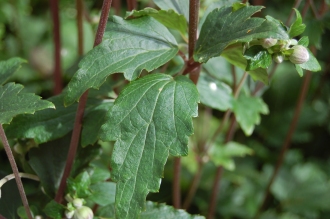Position: Dappled shade (will tolerate full sun)
Flowering period: Late summer to Autumn
Soil: Moist, well drained
Eventual Height: 1m
Eventual Spread: 60cm
Hardiness: 4b, 5a, 5b, 6a, 6b, 7a, 7b, 8a, 8b, 9a
Family: Ranunculaceae
Anemone hupehensis ‘Splendens’ is a deciduous, herbaceous perennial with an upright, clump forming habit. Its dark green leaves are deeply divided with three leaflets. Its hermaphrodite flowers are cup shaped, are deep pink with yellow centres, up to 6cm across and appear at the ends of erect stems. Its roots are fibrous, these send out suckers from which this plant propagates its self.
The species Anemone hupehensis , commonly known as Japanese Windflower, Japanese Anemone or Japanese Thimbleflower, is native to Central China.
The etymological root of the binomial name Anemone may be a derivation of the Hebrew word for Adonis. Hupehensis is from the Latin meaning ‘ from Hupeh’ province, China.
The landscape architect may find Anemone hupehensis ‘Splendens’ useful as a late summer flowering, low maintenance herbaceous perennial, particularly useful as under planting. It looks good when planted en mass and is suitable for prairie style planting. It will tolerate full sun providing sufficient soil moisture is present.
Ecologically, Anemone hupehensis ‘Splendens’ is attractive to pollinating insects. The larval stage of some moths and butterflies may feed on the foliage of this plant.
Anemone hupehensis ‘Splendens’ prefers moist, humus rich, well-drained soils. It tolerates most pH of soil. It will not tolerate wet or dry soils.
Anemone hupehensis ‘Splendens’ requires little maintenance. Dying foliage may be cut back in autumn. Large clumps may be divided in spring.








Leave a comment